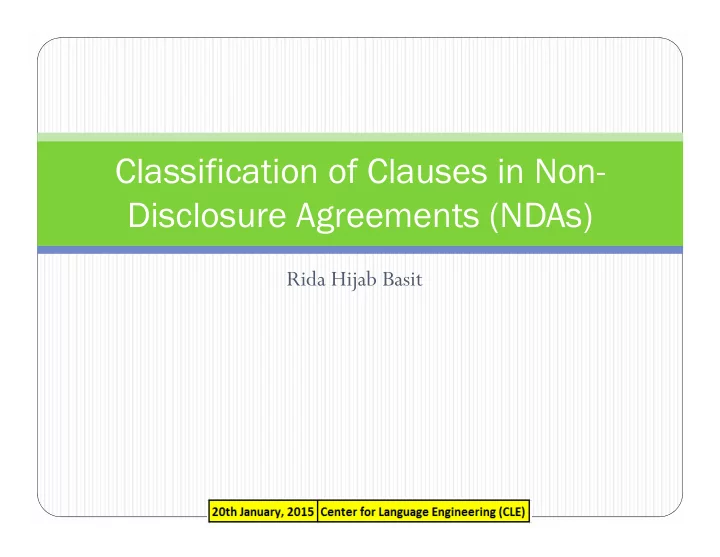

Classification of Clauses in Non- Disclosure Agreements (NDAs) Rida Hijab Basit
Overview Non-Disclosure Agreements (NDAs) Examples of Clauses in NDAs Pre-processing Feature Extraction Dataset Classification Results
Non-Disclosure Agreements (NDAs) Non-Disclosure Agreement is a legal contract between at least two parties that outlines confidential material, knowledge, or information that the parties wish to share with one another for certain purposes, but wish to restrict access to or by third parties.
Examples of Clauses THIS AGREEMENT (the 'Agreement') made as of the 1st day of December, 2013 BETWEEN: Bank of Montreal, a Canadian chartered bank, with an office at 100 King Street West, Toronto, Ontario, Canada, M5X 1A1 (called 'BMO') - and - Vaultive Inc., having an office at 489 Fifth Avenue, 31st Floor, New York, NY, U.S.A, 10017 (called \"Supplier\") 2.6 Notwithstanding the foregoing, BMO may disclose Confidential Information of the Supplier to any member of the BMO Financial Group for any purpose without a written confidentiality agreement in place between BMO and such member of BMO Financial Group.
Data Format Legal contracts in the form of text files. Contracts consist of various clauses/sentences that need to be classified
Data Pre-Processing Has be divided into three phases Tokenization (Sentence Segmentation) Based on full stop & question mark Full Stop can also come at some place other than the end of the sentence like Dr., Mr., John F. James etc. To handle this, an exception list has been generated Cleaning (Removal of stop words) Words like “the”,“of” etc. Stemming (Reduction of words to their stems) Receiving, received, receives all stemmed to receive
Feature Extraction Lexical level features have been used.These are: Bag ofWords (Window Size = 3 – 5) N-grams (N = 1-3) For each feature, itsTF-IDF values have been computed TF-IDF stands for Term Frequency – Inverse Document Frequency
Dataset Total labels = 29 Total sentences = 7926 (Marked as clauses and assigned labels manually) Selection of Training and Testing Dataset Training Instances = 6342 Testing Instances = 1584
Classes No. of Sentences Parties Bound 567 Inclusion of affiliates 60 Unilateral agreement 185 Mutual Agreement 210 Business Purpose 243 Definition of confidential information 421 Publicly available information carveout 232 Already in possession carveout 167 Received from a third party not obligated carveout 164 Independently developed without use of confidential information 145 Disclosure required by law carveout 407 Trade Secrets covered 97 Includes information indirectly disclosed 11 Use restrictions 273 Record keeping obligation 20 Return or Destroy Information 292 Certification obligation 102 Non-Solicitation 771 Non-Contact 31 Exception for ordinary course 7 Indemnification 623 Survival of obligations 323 Period specified 124 Terminates when definitive agreement signed 48 Remedies 453 Including equitable relief 950 Governing Law 946 Residuals 45 Gramm-Leach-Biley 9 Total 7926
Classification Various classification algorithms have been tested using Weka (Ian H. Witten, 2000) data mining software. Classification Algorithms include: Support Vector Machine (SVM) Decision Tree Random Forest Naïve Bayes Bagging
Flat-Structure Classification First, flat-structure classification was adopted Tested each feature vector with different classification algorithm Features SVM Decision Naïve Bagging Random Tree Bayes Forest N-grams (Unigram Cutoff 63.64% 55.0505 % 41.0354 % 54.4192 % 57.3864 % = 50 and Bigram Cutoff = 30) Bag of Words (Window Size 58.59% 55.303% 54.9874 % 53.5354 % 56.5025 % = 3, Unigram Cutoff = 100) Bigrams (Cutoff = 40) 56.57% 51.7677 % 36.4899 % 50.947 % 51.1364 % Unigrams 63.57% 57.2601 % 42.6136 % 53.5985 % 58.5859 % Table 1: Flat-Structure Classification Result Analysis
Two-Level Classification Based on experiment results and confusion matrix analysis, two-level classification has been used. Classes with higher confusion are merged resulting into 13 classes at Level 1 Level 2 classification is then performed on merged classes At level 2, 8 different classifiers have been developed with local features
Level 1 Classification Classification Algorithms Accuracy Decision Tree 79.143% Random Forest 82.9868% Naïve Bayes 67.1708% Bagging 80.5293% SVM 87.21% Table 2: Level 1 Classification Result Analysis
Level 2 Classification Classification Algorithms Average Accuracy Decision Tree 73.66% Random Forest 79.94% Naïve Bayes 72.56% Bagging 79.95% SVM 69.10% Table 3: Level 2 Classification Result Analysis
Overall System Performance Based on detailed analysis and experimental results, SVM for Level 1 and Bagging for Level 2 has been selected Using these algorithms, the overall system accuracy turns out to be 78.60%
Related Issues Some labels had less data thus decreasing its accuracy. Some clauses in the training data were given multiple labels. Tokenization issues.
Possible Solution Some of the issues can be resolved by using Rule Based Systems (RBS) before the process of classification
References Ian H. Witten, E. F. (2000). Data mining: practical machine learning tools and techniques with Java implementations. San Francisco: Morgan Kaufmann .
Thank you
Recommend
More recommend